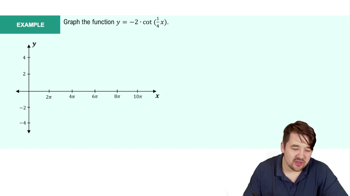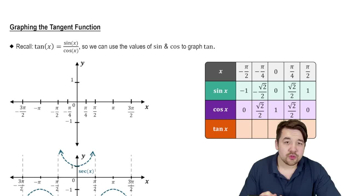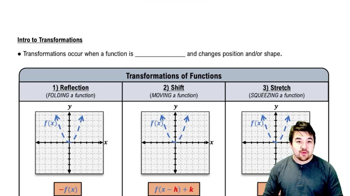Below is a graph of the function . Determine the value of b.
Table of contents
- 0. Functions7h 54m
- Introduction to Functions16m
- Piecewise Functions10m
- Properties of Functions9m
- Common Functions1h 8m
- Transformations5m
- Combining Functions27m
- Exponent rules32m
- Exponential Functions28m
- Logarithmic Functions24m
- Properties of Logarithms36m
- Exponential & Logarithmic Equations35m
- Introduction to Trigonometric Functions38m
- Graphs of Trigonometric Functions44m
- Trigonometric Identities47m
- Inverse Trigonometric Functions48m
- 1. Limits and Continuity2h 2m
- 2. Intro to Derivatives1h 33m
- 3. Techniques of Differentiation3h 18m
- 4. Applications of Derivatives2h 38m
- 5. Graphical Applications of Derivatives6h 2m
- 6. Derivatives of Inverse, Exponential, & Logarithmic Functions2h 37m
- 7. Antiderivatives & Indefinite Integrals1h 26m
- 8. Definite Integrals4h 44m
- 9. Graphical Applications of Integrals2h 27m
- 10. Physics Applications of Integrals 3h 16m
- 11. Integrals of Inverse, Exponential, & Logarithmic Functions2h 31m
- 12. Techniques of Integration7h 41m
- 13. Intro to Differential Equations2h 55m
- 14. Sequences & Series5h 36m
- 15. Power Series2h 19m
- 16. Parametric Equations & Polar Coordinates7h 58m
0. Functions
Graphs of Trigonometric Functions
Problem 97
Textbook Question
Identify the amplitude and period of the following functions.
g(θ)=3cos(3θ)
 Verified step by step guidance
Verified step by step guidance1
The given function is g(θ) = 3cos(θ/3). This is a cosine function of the form a * cos(bθ), where a is the amplitude and b affects the period.
Identify the amplitude: In the function g(θ) = 3cos(θ/3), the coefficient of the cosine function is 3. Therefore, the amplitude is the absolute value of this coefficient, which is |3| = 3.
Determine the period: The period of a basic cosine function cos(θ) is 2π. For a function of the form cos(bθ), the period is adjusted by the factor b, and is given by the formula 2π/|b|.
In the function g(θ) = 3cos(θ/3), the value of b is 1/3 (since θ/3 can be rewritten as (1/3)θ). Therefore, the period is 2π divided by 1/3, which simplifies to 2π * 3.
Thus, the amplitude of the function is 3, and the period is 6π.
 Verified video answer for a similar problem:
Verified video answer for a similar problem:This video solution was recommended by our tutors as helpful for the problem above
Video duration:
2mPlay a video:
Was this helpful?
Key Concepts
Here are the essential concepts you must grasp in order to answer the question correctly.
Amplitude
Amplitude refers to the maximum value of a periodic function, specifically the height of the wave from its midline to its peak. In the function g(θ) = 3cos(θ/3), the amplitude is represented by the coefficient of the cosine function, which is 3. This means the function oscillates between 3 and -3.
Recommended video:

Introduction to Cotangent Graph Example 1
Period
The period of a periodic function is the length of one complete cycle of the wave. For the cosine function, the standard period is 2π. In the function g(θ) = 3cos(θ/3), the period is affected by the coefficient of θ inside the cosine. The period can be calculated using the formula 2π divided by the coefficient of θ, which in this case is 1/3, resulting in a period of 6π.
Recommended video:

Introduction to Tangent Graph
Phase Shift
Phase shift refers to the horizontal shift of a periodic function along the x-axis. While the given function g(θ) = 3cos(θ/3) does not include a phase shift term, understanding this concept is essential for analyzing more complex functions. A phase shift occurs when the argument of the cosine function is adjusted by a constant, affecting where the wave starts on the x-axis.
Recommended video:

Intro to Transformations

 5:53m
5:53mWatch next
Master Graph of Sine and Cosine Function with a bite sized video explanation from Patrick
Start learningRelated Videos
Related Practice
Multiple Choice
